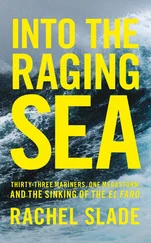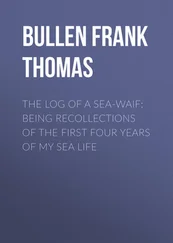The frenzied choreography works most of the time but occasionally things happen—a container slips from the spreader’s grip and crashes back on the flatbed, or it lands misaligned and crushes a longshoreman’s hand as he’s leveling it into place, or a stevedore gets hit by one of the huge trailers being driven off the ship in a great rush.
The huge loading cranes themselves also pose danger. They glide on two tracks that run parallel to the dock along its entire length, allowing the cranes to move from bow to stern and from ship to ship, stacking boxes. In 2008, a squall sent one 950-ton Jacksonville crane careening down the length of two football fields into the next, causing the steel constructs to twist and crumple into a heap of junk. It looked like spaghetti. It’s a rare event—the cranes come equipped with multiple brakes—but shows the kind of power packed in gale-force winds.
Out of the din, Eric saw Jack Jackson coming down the ramp to greet him. Jack was the helmsman on the 8:00 to midnight watch that night; he’d stand at the ship’s wheel on the navigation bridge and take steering commands from Eric. When they reached the sea buoy, Eric would disembark, leaving the captain in charge.
Sixty years old, sun-bleached yellow hair fading to white, ruddy face with a devilish grin, Jack had a wry sense of humor that could catch you off guard. He was the middle brother in a family of self-ascribed air force brats, mostly raised in New Orleans. Dad would show the kids pamphlets of the places they were moving next. Delaware! Beaches! Jack’s older sister, Jill, moved frequently; she was a restless soul. Younger brother, Glen, with his ginger hair and blue eyes, could’ve been Jack’s twin, but he was more a traveler of the mind.
When Jack and Glen were boys in New Orleans in the 1960s, there were four major shipping companies keeping the port busy. They used to ride out to the big bend in the river to watch the ships. Two sunburned boys dreaming on the banks of the Mississippi. The boats were always going somewhere, just like their family, always moving. That’s where the fascination began, Glen says.
Jack signed up with the merchant marine during the 1970s to explore the world, make some money, live free. He enjoyed the easy sea life delivering grain to Africa or going back and forth to Europe. In those days, ships would spend days or weeks in a port loading and unloading so he could get off and poke around. Just one big adventure.
Jack had a magical aura about him; people were drawn to him. He once owned a motorcycle—a Norton. One day when Jack was stopped at a red light, a girl jumped on. She said she liked Nortons. They lived together for a year. That’s how life was back then.
Jack was easygoing. He never pursued an officer’s license or tried to hustle up the ranks; he preferred to avoid the messy politics aboard. He saw how cutthroat officers were; getting ahead wasn’t worth the increase in pay and the hassle. Guys with higher ranks would sit in union halls for days waiting for work but as a general able-bodied seaman, called an AB, Jack could always get work whenever the spirit moved him. Sailing, living free.
Decades later, Jack was still shipping out, and in a way, so was Eric. But Jack had fully embraced the seaman’s life; he lived alone in Jacksonville and had never married. During shore leave, he carved sculpture out of wood and painted dreamy Edward Hopper–like scenes. He once told Eric that when he retired, he planned on throwing an oar over his shoulder and walking west until someone asked him what it was.
Eric was pleased to see his fellow traveler on duty that night. Guys like Jack made the heavy workload on these short, busy runs down to San Juan go a little smoother.
Working ships are an obstacle course of cargo, safety equipment, and machinery and as Jack led Eric from the ramp to the ship’s house, he casually pointed out anything—raised thresholds, low headers—that Eric might trip over or bang his head on.
Though El Faro had an elevator, the captain on duty didn’t want the crew using it. Someone could get stuck in there. The machinery was old and cranky, and he worried that it might stop working entirely because the shipping company had stopped paying to have it inspected. If it did quit with someone inside, the ship’s engineers would have to spend their time fixing the lift instead of tending to the ship’s ancient steam plant.
So Jack and Eric climbed seven flights of industrial stairs bathed in fluorescent light to get to the navigation bridge. Each floor in the ship’s house served a function. Ascending, they passed the galley, the crews’ quarters, engineers’ quarters, deck officers’ quarters—each door clearly labeled—to the final set of stairs, through the door to the bridge where the captain and the third mate were waiting for them.
Nearly ten stories above the waterline, the navigation bridge was a single room atop the house with seven windows framing the evening sky as the sun set over Jacksonville. It smelled like old solder and aging wiring, an olfactory blast from the 1970s, a reminder that the ship was forty years old—built before the internet, laptops, and cellphones—and nearly double the age of the average ship docked in America’s ports.
Against the windows sat a file-cabinet-gray metal console as wide as the bridge, strewn with instruments. In the middle of the console, waist-high, was a small black steering wheel, like something you’d find on a Honda Civic. It was hard to believe that such an inconsequential thing controlled the massive rudder below. A couple of solid wood grab bars were attached to the console; even on this giant vessel, things could get rough. Tucked in the corner was the chartroom; a blackout curtain took the place of a door.
Captain Michael Davidson greeted Eric. Davidson was a Yankee like the pilot. He had signed on with the shipping company—TOTE—two years ago, and the pair had met here on the bridge a few times. Davidson stood a few inches shorter than Eric and wore his white-and-gray hair close cropped, military style. He had an athletic build, sharp nose, and Scottish eyes that sloped down in a friendly, generous way when he smiled, complementing his cleft chin. A slightly imperious manner betrayed his station as master of the ship. He shook Eric’s hand firmly, calling him “Mr. Pilot.”
“Hello, Cap’n,” Eric said.
Eric opened the door to the bridge wing and stepped into the warm evening air, high above the river. Below him, a pair of pelicans flew over the stacks of containers. Eric had a portable GPS system that came with an antenna that worked best out here; he positioned it carefully on the small deck, sheltered from the wind. The antenna sent his precise location back inside to his iPad, which was loaded with a detailed chart of the St. Johns River, its depths, and live traffic information. The keel of El Faro cut a wake three stories below the waterline, a comfortable depth for the river’s forty-foot dredged channel, but at various locations, tolerances were tight.
Eric’s handheld software was more sophisticated than El Fa ro ’s onboard technology. El Faro didn’t have an electronic chart system, soon to be required of all international deep-draft vessels. Instead, her officers relied on their paper nautical charts published by NOAA (National Oceanic and Atmospheric Administration), and a crude alphanumerical GPS interface.
Eric always steered ships with his eyes first, technology second. He knew the river like he knew the streets of his own neighborhood, but he regularly referred to his iPad to check his work.
Jack Jackson handed the pilot a cup of coffee and took the wheel at eight o’clock as two tugs below slowly spun El Faro 180 degrees to point her bow toward the Atlantic Ocean, 10.6 miles down the winding river. When she was in position, the tugs pulled their lines and El Faro glided silently forward under her own power. They were underway.
Читать дальше












